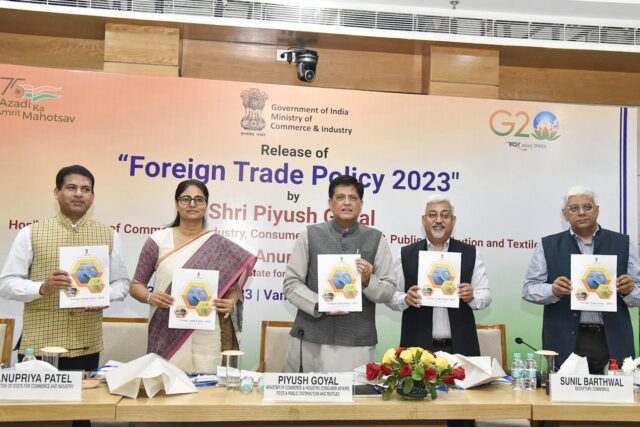India unveiled a “dynamic and flexible” foreign trade policy on Friday, 31st March 2023 with the goal of boosting the rupee’s trade, raising exports to USD 2 trillion by 2030, and fostering e-commerce exports. The Foreign Trade Policy (FTP) 2023 has the following tack: it shifts from an “incentive to remission” based system, promotes cooperation between exporters, states, districts, and Indian missions, lowers transaction costs, and expands export hubs.
India’s exports of goods and services are expected to surpass USD 765 billion in the fiscal year 2022–23, which ends on Friday, and the country plans to more than double those exports to USD 2 trillion over the following seven years. The preceding fiscal year’s exports totaled USD 676 billion. The government has this time announced a flexible and responsive trade strategy that will be adjusted in accordance with the shifting international environment, as opposed to the customary 5-year FTPs.
The FTP 2023, which was introduced by Commerce and Industry Minister Piyush Goyal, has not set an end date and will be updated on a regular basis, Director General of Foreign Trade (DGFT) Santosh Sarangi assured the media. Goyal stated that over the next 4-5 months, the Department of Commerce will conduct significant, targeted outreach to the world, either sectorally or country-wise. The agency would collaborate with the Ministry of External Affairs and Indian missions abroad.
Although they will have exported USD 2 trillion worth of goods by 2030, it shouldn’t be the case that the exports of merchandise are outperformed by service exports. A futuristic piece of legislation emphasizing technology and commerce facilitation. Future real-time updates will make it possible for businesses to actively participate in governmental decision-making. The emphasis on streamlining SCOMET procedures is shown in proposals like the reduction of MSME user fees for Trade Licenses and the special one-time amnesty for export obligation default. Government focuses on lowering exporters’ compliance burden, acknowledging their struggles, and simplifying rules, according to Principal of Price Waterhouse & Co. LLP Gautam Khattar.
In addition to the 39 existing Towns of Export Excellence (TEEs), the recently released FTP 2023 highlights the identification of four new TEEs: Faridabad, Moradabad, Mirzapur, and Varanasi. E-commerce exports are one of the core components of the FTP 2023 and are anticipated to reach USD 200-300 billion by 2030.
The per-consignment value cap for exports via courier service has been raised from 5 lahks to 10 lahks. The recently unveiled FTP 2023 proposes to internationalize the Indian rupee and facilitate international trade settlement in the home currency. The FTP 2023 is intended to be dynamic and flexible to changing trade conditions, according to the DGFT. In order to assure its future readiness, the Department of Commerce is also going through a restructuring process.
Another noteworthy aspect of the policy is the extension of a special advance authorization program for the garment and clothing industry in order to speed up the execution of export orders. The dairy sector is also exempted from maintaining an average EO. The action will help the industry modernize its technologies.









